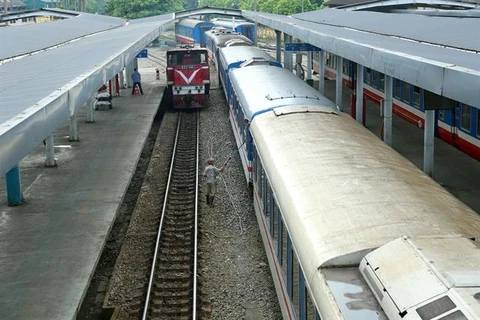Hanoi (VNS/VNA) - The State must play a key role in investing in the national railway infrastructure to boost development and attract more private investment, experts have said.
Speaking at the seminar on promoting the railway infrastructure development held on September 25, Deputy Minister of Transport Nguyen Ngoc Dong said the cost of investment in a kilometre of railway infrastructure is usually three to four times higher than that of roadway.
In addition, the sector had a slow pay-back ability making it tough to call for investment from private sectors.
Dong said the sector has improved with the investment in the North-South high-speed railway, which helped to maximise the capacity of the transport system in Vietnam.
However, the aging and backward infrastructure system has posed many challenges.
Most of the trains operated on the one metre gauge, which accounted for 85 percent of the national railways.
There were 297 terminals in the whole country, but most were small and downgraded. Half of 1,850 railway bridges were in dire need of being upgraded. At least 22 out of 39 railway tunnels also need renovation.
More than 4,000 railway crossing were illegally built across the country, where up to 70 percent of railway accidents occurred.
Vu Anh Minh, Chairman of the Vietnam Railways Corporation, said the capital demand for railway development was huge, but the investment for the sector was modest - only two percent of the State budget.
The annual funding for maintenance allocated by the Government could only satisfy about 30 percent of the actual needs.
Out-of-date technology and ill-quality services weakened the competitiveness of the sector, he said.
Le Thanh Van, Standing Member of the National Assembly's Finance and Budget Committee, said the railway sector has lost its role in the economy with the market share decreased from 30 percent to 1 percent.
This was totally contradictory to the development of roads and airways, he said.
Discussing on the causes of the issue, Van said the State has not had a strategic vision of railway planning and paid little attention to investment.
On the other hand, the railway industry itself still depended on the State’s investment and was not active in restructuring its organisation to adapt to fierce competition.
That’s why it was very difficult to attract investment from the private sectors.
Le Thanh Quan, Director of the Ministry of Planning and Investment’s Department of Infrastructure and Urban Development, said the funding raised from 4 percent in the period of 2011-2015 to 11.9 percent in the period of 2016-2020.
However, it has remained insufficient to the actual demand.
Due to limited investment, the development strategy of the national railway industry by 2020 with a vision to 2050 only targeted that the market share of the industry would be 1-2 percent of passenger transport and 1-3 percent of freight transport.
At the meeting, experts said it was vital the State invest in key infrastructure.
A policy to attract investment from private enterprises should be built.
The transport sector must focus on technology to lengthen station tracks, build new stations, synchronise axle load on the entire route and modernise signalling and telecom systems to improve the operation capacity./.
VNA

























